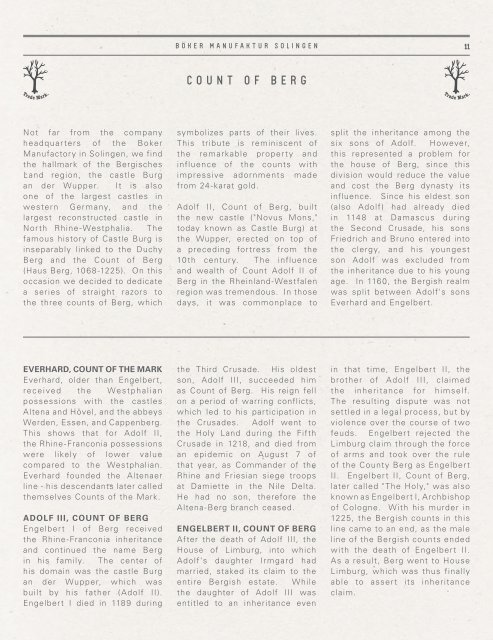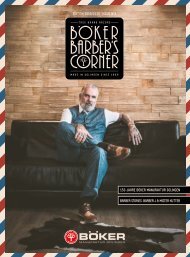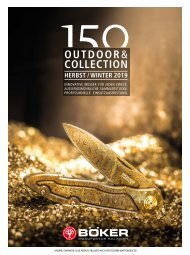Boker Barbers Corner | BUSA Edition 2019
Create successful ePaper yourself
Turn your PDF publications into a flip-book with our unique Google optimized e-Paper software.
BÖKER MANUFAKTUR SOLINGEN<br />
11<br />
COUNT OF BERG<br />
Not far from the company<br />
headquarters of the <strong>Boker</strong><br />
Manufactory in Solingen, we find<br />
the hallmark of the Bergisches<br />
Land region, the castle Burg<br />
an der Wupper. It is also<br />
one of the largest castles in<br />
western Germany, and the<br />
largest reconstructed castle in<br />
North Rhine-Westphalia. The<br />
famous history of Castle Burg is<br />
inseparably linked to the Duchy<br />
Berg and the Count of Berg<br />
(Haus Berg, 1068-1225). On this<br />
occasion we decided to dedicate<br />
a series of straight razors to<br />
the three counts of Berg, which<br />
symbolizes parts of their lives.<br />
This tribute is reminiscent of<br />
the remarkable property and<br />
influence of the counts with<br />
impressive adornments made<br />
from 24-karat gold.<br />
Adolf II, Count of Berg, built<br />
the new castle ("Novus Mons,"<br />
today known as Castle Burg) at<br />
the Wupper, erected on top of<br />
a preceding fortress from the<br />
10th century. The influence<br />
and wealth of Count Adolf II of<br />
Berg in the Rheinland-Westfalen<br />
region was tremendous. In those<br />
days, it was commonplace to<br />
split the inheritance among the<br />
six sons of Adolf. However,<br />
this represented a problem for<br />
the house of Berg, since this<br />
division would reduce the value<br />
and cost the Berg dynasty its<br />
influence. Since his eldest son<br />
(also Adolf) had already died<br />
in 1148 at Damascus during<br />
the Second Crusade, his sons<br />
Friedrich and Bruno entered into<br />
the clergy, and his youngest<br />
son Adolf was excluded from<br />
the inheritance due to his young<br />
age. In 1160, the Bergish realm<br />
was split between Adolf's sons<br />
Everhard and Engelbert.<br />
EVERHARD, COUNT OF THE MARK<br />
Everhard, older than Engelbert,<br />
received the Westphalian<br />
possessions with the castles<br />
Altena and Hövel, and the abbeys<br />
Werden, Essen, and Cappenberg.<br />
This shows that for Adolf II,<br />
the Rhine-Franconia possessions<br />
were likely of lower value<br />
compared to the Westphalian.<br />
Everhard founded the Altenaer<br />
line - his descendants later called<br />
themselves Counts of the Mark.<br />
ADOLF III, COUNT OF BERG<br />
Engelbert I of Berg received<br />
the Rhine-Franconia inheritance<br />
and continued the name Berg<br />
in his family. The center of<br />
his domain was the castle Burg<br />
an der Wupper, which was<br />
built by his father (Adolf II).<br />
Engelbert I died in 1189 during<br />
the Third Crusade. His oldest<br />
son, Adolf III, succeeded him<br />
as Count of Berg. His reign fell<br />
on a period of warring conflicts,<br />
which led to his participation in<br />
the Crusades. Adolf went to<br />
the Holy Land during the Fifth<br />
Crusade in 1218, and died from<br />
an epidemic on August 7 of<br />
that year, as Commander of the<br />
Rhine and Friesian siege troops<br />
at Damiette in the Nile Delta.<br />
He had no son, therefore the<br />
Altena-Berg branch ceased.<br />
ENGELBERT II, COUNT OF BERG<br />
After the death of Adolf III, the<br />
House of Limburg, into which<br />
Adolf's daughter Irmgard had<br />
married, staked its claim to the<br />
entire Bergish estate. While<br />
the daughter of Adolf III was<br />
entitled to an inheritance even<br />
in that time, Engelbert II, the<br />
brother of Adolf III, claimed<br />
the inheritance for himself.<br />
The resulting dispute was not<br />
settled in a legal process, but by<br />
violence over the course of two<br />
feuds. Engelbert rejected the<br />
Limburg claim through the force<br />
of arms and took over the rule<br />
of the County Berg as Engelbert<br />
II. Engelbert II, Count of Berg,<br />
later called "The Holy," was also<br />
known as Engelbert I, Archbishop<br />
of Cologne. With his murder in<br />
1225, the Bergish counts in this<br />
line came to an end, as the male<br />
line of the Bergish counts ended<br />
with the death of Engelbert II.<br />
As a result, Berg went to House<br />
Limburg, which was thus finally<br />
able to assert its inheritance<br />
claim.

















